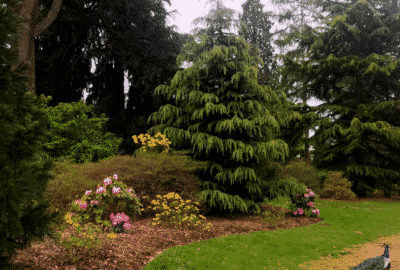Can we talk to bees?
Wednesday 27th Mar 2024, 12.30pm
We are out in the wild today talking to bees!
In this behind the scenes episode, we visited Dr Rachel Parkinson’s bee recording studio to see insect neuroscience research in action.
You might know that honeybees communicate with each other using the waggle dance, a minute choreography that shows other bees the way to the flower buffet. But little is known about how bumblebees communicate.
To understand more about bee behaviour, Rachel has created a series of small arenas with cameras and microphones. Using AI, visual and audio recordings can be matched up to create a database of sounds and behaviours which will, in time, hopefully reveal the secret language of bees!
Emily Elias: Okay, I’m here at the John Krebs Field Station, and it’s a big day. We are going to channel our inner Doctor Doolittle, and we’re going to ask a question involving bees this week. We are going to see if we can talk to some. AI is involved, and we are going to ask, can we talk to bees?
I’m Emily Elias, and this is the Oxford Sparks Big Questions podcast, where we find the brightest minds in the University of Oxford and we ask them the big questions. And for this one I have found a researcher who is absolutely buzzing.
Rachel Parkinson: I am Rachel Parkinson. I’m a neuroethologist, so I’m a neuroscientist who’s also very interested in natural animal behaviour. I am a researcher at the University of Oxford in the Department of Biology, and I am really, really interested in bees. What they are sensing in the world, what they do with that information, how different things that we put into the environment affects them. Yeah, I want to know everything about how their brains work and why they do the behaviours that they do.
Emily: Okay, so I guess a big part of figuring out why they do the behaviours that they do comes down to, can they communicate with each other? Do they talk to each other? Obviously, there must have some form of communication, otherwise it would just be bee chaos, and we never have these wonderful hives and honey and all sorts of things that they do for us. So what do we actually know about how bees communicate?
Rachel: So, we know quite a lot about how honey bees communicate with each other. One of the ways that they do that is through something called the waggle dance, which is a special little dance routine that they do to tell other bees the exact directions to some sort of, you know, flower source. Something delicious to eat. So that’s one kind of communication that we know about. We know also that insects communicate using pheromones. But I’m specifically looking at bumblebees, which are the cute, fuzzy bees that we find in many places in the world. And in the UK, we have a bunch of different species, which is really exciting. And we don’t know as much about what bumblebee communication looks like or how they’re communicating with each other in the nest using vibrations or other kinds of audible sorts of signals.
Emily: How are you going to study it? What are you doing?
Rachel: So I’ve developed this bee recording studio, which is, yeah, it’s quite a contraption. And essentially, it’s a small, little arena, a little cage where the bees can live, and there’s a camera so that I can watch what they’re doing and also a microphone to pick up the different sounds that they’re making. And so I can put them in this contraption and record what they’re doing and what they’re saying over time.
Emily: Oh my God, can I see this?
Rachel: You can see it. Okay, let’s go check it out. So they’ve given me my own little special room, which is quite exciting because it’s a room that was formerly known as the duckling room. And then it went through a configuration where it was known as the goldfish room. You might be catching a trend, we’re naming it after, you know, the animals that have lived there. And now it’s mine and it’s hiding in this funny space behind the photocopier room.
Okay, it says, please be quiet, bees at work.
Emily: I love a pun. It’s the bee lab!
Rachel: Yep, yep, yep. That’s right. So this is my teeny, tiny little space. And it was a purpose built space for actually keeping, again, you know, animals, ducklings, things like that. So we have all these fun training rooms, but, my equipment is all set up in these two rooms. So in here, I have the first set of recording studios, and there’s actually some bees in here right now.
Emily: Oh my God.
Rachel: These are presently recording, but none of them have the lights turned on, which means that we’re sort of between a recording segment.
Emily: Can you just describe what this looks like for people.
Rachel: Yeah, absolutely. So I have laser cut these stands which are holding the microphone and the camera, and a little raspberry PI, which is not a tasty thing, but rather a very small computer that is kind of a fun plug and play device to use with electronics. And then the bees themselves are housed inside of these clear acrylic boxes, that have lots of air holes, and they have access to a tube of sugary, delicious food for them to drink. And so when they’re in these boxes, I can record using the camera and as well the microphone. And also I’m taking other sort of measurements, like the temperature and the humidity that’s going on in there. So this is the equipment.
And then I have each of these contraptions housed inside of its own tiny recording studio, its own little sound box. So there’s soundproofing insulation on the inside of these boxes to try to dampen a little bit some of the outside sounds, and the sounds from the bees going into the other recording studios.
Emily: They’re like the size of, like, I want to say, like a 1995 era computer that would have been like the first computer that your family would have had for elder millennials.
Rachel: Yeah. So they’re, yeah, they’re 45 cm tall. They’re tower shaped, so they’re not very wide. Oh, this one’s turning on.
Emily: Oh, so this red light’s gone on. What does that mean?
Rachel: It’s going to be a [beep]. Did you hear that little buzz? So that sound is what’s called a time clapper. So I have the sound go beep, beep, beep, beep, beep. At the same time that a little LED flashes. And that’s just to help sync up the microphone with the camera.
Now it’s recording what this bee is doing. But check it out. That bee is definitely asleep. So not going to be doing very much at this exact moment.
Emily: Do bees make sound when they’re sleeping?
Rachel: No, they stay very still when they’re sleeping. It’s actually, you might be able to hear this one making a sound over here that’s flying around. [bee buzzing]
Emily: He’s a much more active bee. I can definitely hear him. He’s sort of like flying around the edges of his little clear box and touching all his little air holes. What is he doing? Is he just having an explorer?
Rachel: Well, first things first, all of these bees are female, so these are all shes in this particular setup. And what she’s doing is probably trying to escape, actually. So these bees have been in this setup for about the last 45 minutes. So the ones that are really curious are still trying to look through all of the different possible places where they might be able to escape.
Bees are super curious. So when they’re not sleeping, they’re very often just wandering around and looking for stuff. So if you put like, a little, you know, piece of cotton wool in there, they’ll, like, manipulate it and play around with it. If they can see any possible way of kind of crawling out, they’ll definitely capitalise on it. They’re little escape artists and, yeah, otherwise they’ll go towards where their food is and have a little drink.
Emily: Okay, so let’s get into this. So you’re recording all of these bees, how are you able to tell what they’re doing? Like, do you put things in there to, like, stress them out or make them happy or like, to get different sounds?
Rachel: Yeah. So this particular experiment, I’m not providing them really with anything specific that they need to be doing, but the food that they’re consuming has very low concentrations of pesticides in them. And so what I want to know is when there’s a small amount of pesticides present, do they behave the same as when there isn’t? So are they spending similar amounts of time sleeping? Are they similarly active?
Are they able to fly around and crawl around the sides of the cage? Or are they spending most of their time just immobile at the bottom of the cage? Because I want to be able to find, like, are there markers of when they’re not feeling very well? So that’s the purpose of this specific experiment.
I have another experiment going on just next door that we can look at as well, where we have little bumblebee hives that are inside of these cages. And in that case, we’re looking at the nest behaviour and trying to understand how the bees are communicating with each other when it comes to raising young.
Emily: But, okay, so how does this work then? You put them in and record their sound and what you can automatically, it’s like Duolingo for bees, you can automatically tell what their saying.
Rachel: Oh, that’s the end goal. I really would love to get to a point where I can put a bee into this contraption and be able to know something about that bee, for example, how it’s feeling. So I’m using AI to try to decode, I guess, the kinds of things that they’re saying and the circumstances in which they’re saying them.
Emily: Why would you need AI for this? Like, if you were just a gal with a spreadsheet, how long would this take you versus using AI?
Rachel: Yeah, that’s really the main thing. It’s the time investment would be so huge because, you know, traditionally or historically, when we do these kinds of behavioural assays, you have to literally sit there and sort of play back recordings and put timestamps and labels every time you might hear something or see them do a particular thing. But the joy of AI is that we can feed it data that really hasn’t been labelled at all, so just recordings that have been made and it learns things about those recordings. So it learns, ah, the bee moves in this particular way every so often. Okay, that’s gonna be, we’re gonna classify that as, like, one single behaviour so it really speeds up the process. And then once the model is built and is sort of perfected, then we can just feed it lots of new data, and it will be able to decode it really quickly.
Emily: Why would you want to talk to bees?
Rachel: I just want to know what’s going on in their tiny heads.
Emily: Of course. Duh.
Rachel: Right? So I guess the main driver for me is the ability to I guess see how the bees are feeling. So use this as a tool for diagnosing toxicity or illness in bees. We really don’t have a standardized way to test different compounds that are being released into the environment and so most of these tests are done using what’s called the lethal endpoint. So they will feed a bee whatever pesticide they want to start selling and figure out how much of that pesticide is required to kill the bee and then scale down the dose that they allow in the environment.
But the problem is that so many really drastic effects on behaviour happen at concentrations that can be orders of magnitude lower than the concentration required to kill them. But to devise an experiment to test these kinds of things, it’s really difficult. And so there is so much literature that shows that pesticides, like the neonicotinoid pesticides, they affect learning and memory, they affect behaviour of bees in a hive, they affect navigation, they affect all kinds of different individual behaviours. But because the methods that were used in every experiment are so different, it’s hard to compare this compound is worse or better than this compound.
So we really need some sort of standardisation. So that’s kind of one of my big dreams with this project. And the other one is, you know, just in a basic sense to get a better understanding of what is it that these bees are doing when they are in the hive. And is it the same across different species or do different species behave in slightly different ways? And why might that be, considering their biology, their ecology, their evolution?
Rachel: Yeah, so I kind of have these two general interests. One that’s more basic science and one that’s more applied and toxicology related.
Emily: Okay, I don’t want to put any pressure on you, but how long do you think this is going to take to get some results?
Rachel: We are so close now. So it took a very long time to get all of the equipment working properly. You know, to get the stands to be the right height, the microphones to be the right type, just working out all the kinks of the computer program. So that part is behind us now. Now we’re in sort of the major data collection stage, but thankfully we can analyze data at the same time. So I’m really hoping.
[Beep] Oh, yeah, these are all going to just continue now.
I’m really hoping that kind of in the next four to six months we’re going to have this model that’s going to be ready to just take in lots of data and tell us what bees are talking about.
Emily: And could you apply this to not just bees, but other insects that might go buzz buzz, hum hum.
Rachel: Absolutely. Yep. So that’s kind of the next stage is bringing different species of insects into the lab and trying to see if the model is robust enough to be able to tell us something about other species and maybe how they’re different.
Emily: So you are the closest thing I will ever probably meet to Doctor Doolittle.
Rachel: [Laughing] That is correct.
Emily: This podcast was brought to you by Oxford Sparks from the University of Oxford, with music by John Lyons and a special thanks to Rachel Parkinson, a fellow Canadian and pride of Saskatoon. Go Saskatoon.
If you enjoyed this podcast, get in touch. Let us know. We’d love to hear from you. We are on social media @OxfordSparks. We also have a website oxfordsparks.ox.ac.uk.
I’m Emily Elias. Bye for now.





